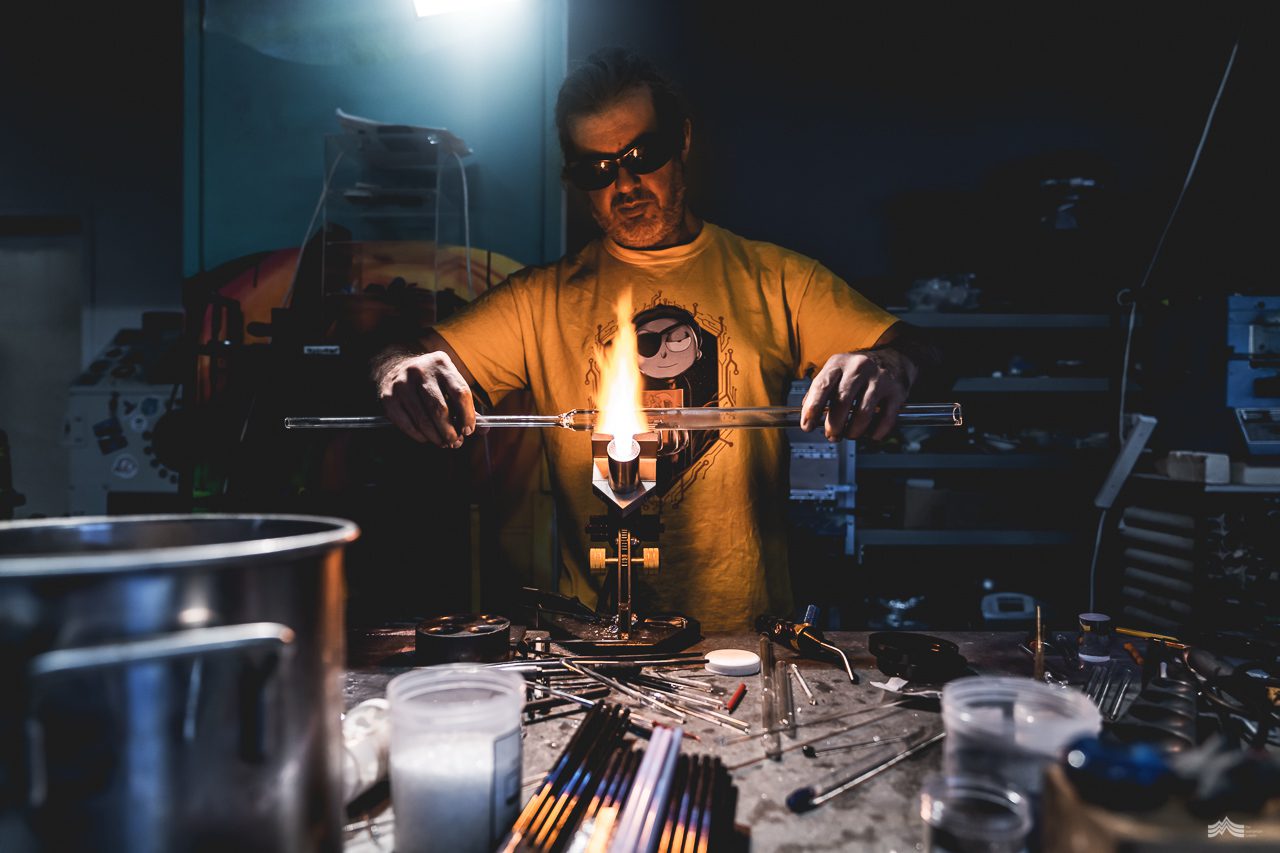Perched on the outskirts of Geeveston in Tasmania’s far south is an unassuming roadside shed. An ice cream factory in a previous life, this unpretentious structure is no longer the domain of chilled treats. It’s been reincarnated as quite the opposite – hiding inside its steel walls lie the molten magic of glassblower Craig Snell.
Craig’s workshop is an eclectic feast for the senses. Step inside and lose yourself between the pulsating beat of some heavy tunes, animated murals splashed across the walls, and the simple glow of the lampworking torch. Temperatures rise in here.
A treasure trove of quirky characters dwell deep within. They’re quiet residents, but outlandishly loud in colour. Shoals of vibrant mudskippers, consortiums of hermit crabs and shivers of striking sharks. With a penchant for perfection and an eye for minute detail, Craig delves deep into technique until he hones the peculiar beasties that emerge from within his flame.
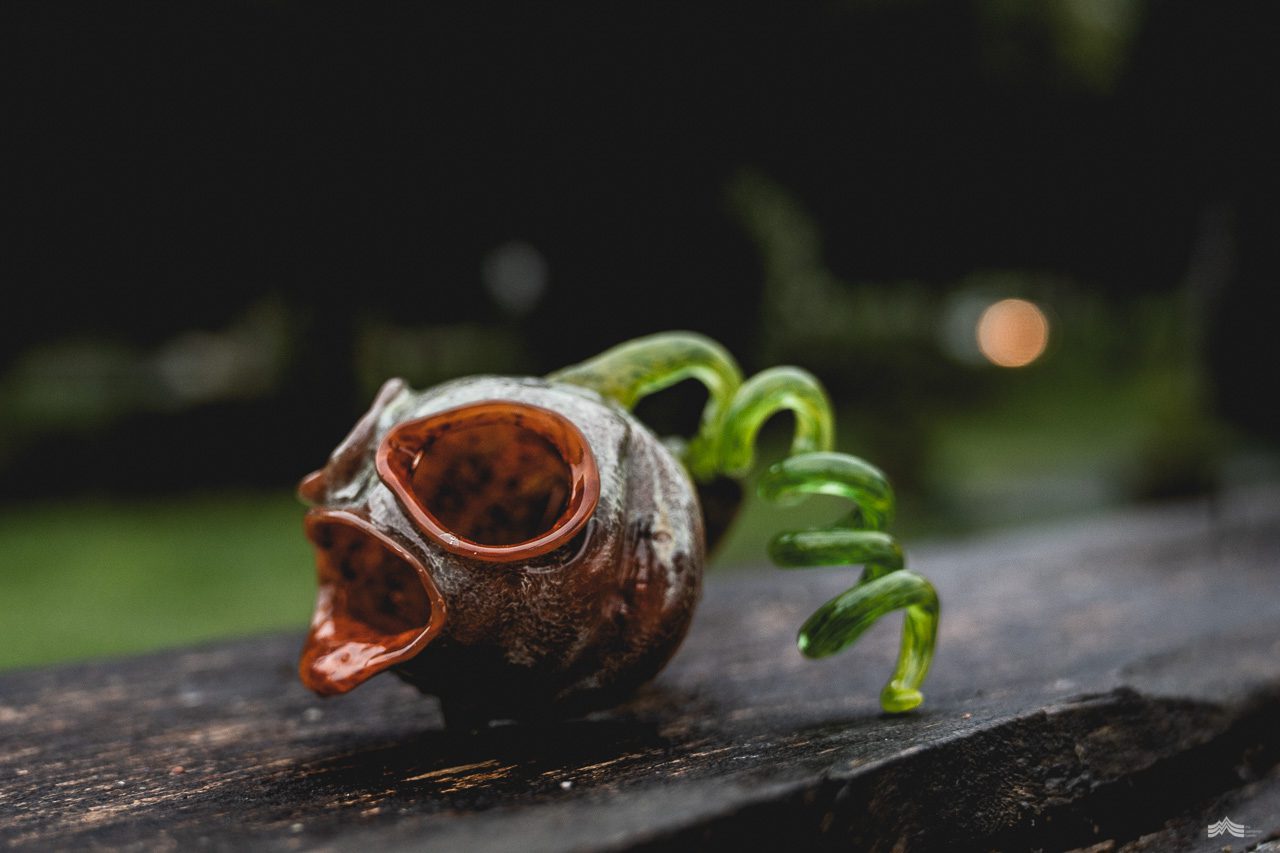
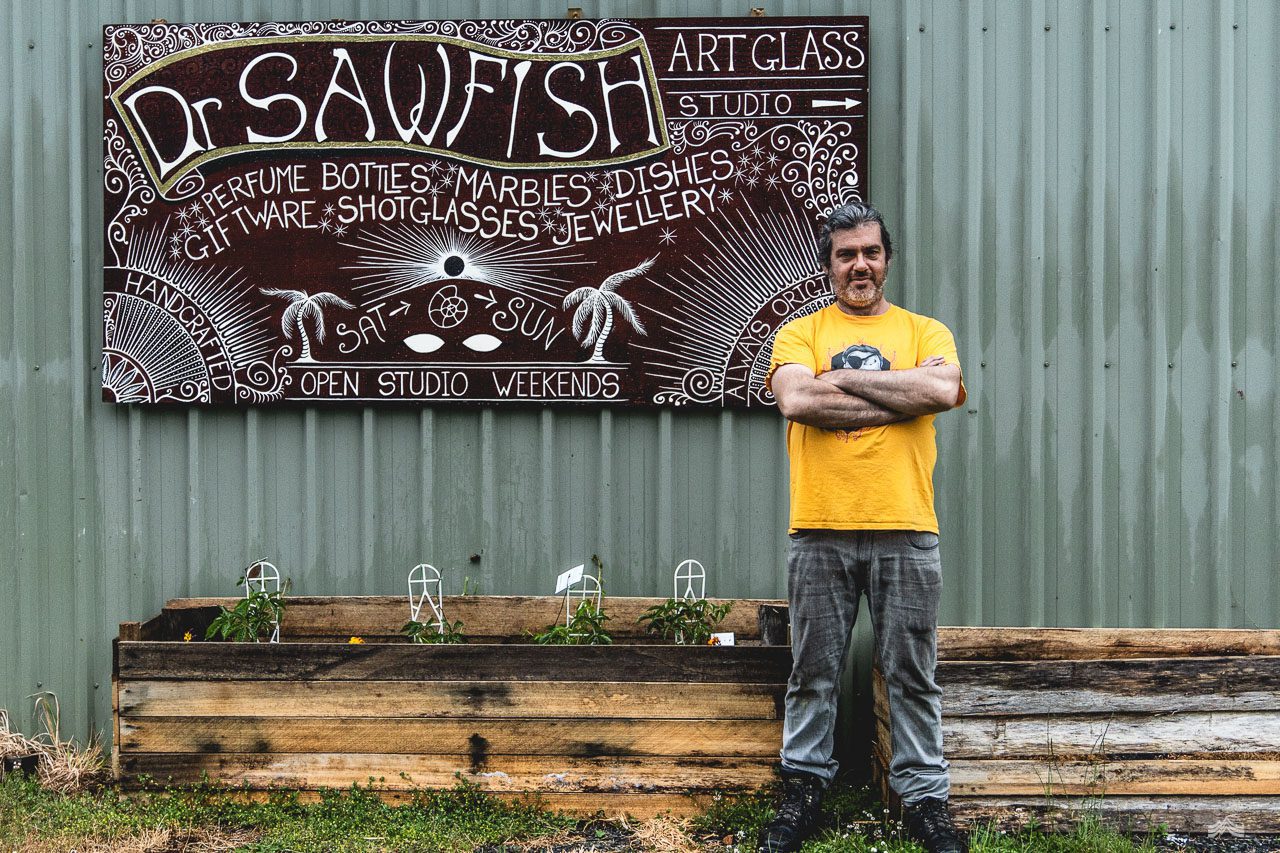

Craig was born and raised in the port city of Bunbury in Western Australia. This warm and jovial character spent a significant portion of his life in the outback – namely Fitzroy Crossing – and is happy to share the journey that led to glassblowing at the bottom of the world. “As a young artist, Bunbury proved less than ideal,” he grins. “While it might have been good for V8s, it certainly wasn’t good for creativity. I left there at 16 and travelled around the country for a while working primarily in screen printing. I’ve certainly had the creative bug for as long as I can remember.”
Following a stint overseas wandering through India, ‘to gain perspective on life,’ Craig retuned to Western Australia, lending his artistic skills to a number of Aboriginal corporations. “It was really rewarding passing on not just my screen printing skills but also pottery skills that I’d also refined. I’ve invested a lot of time over the years… setting up community arts centres…indigenous corporations…teaching at women’s resource centres…just sharing my knowledge really. Nothing that paid super well of course, but totally rewarding experiences that will always stay with me.”
Working with glass had always lingered in the back of Craig’s mind. “I’ve always been fascinated with it,” he nods enthusiastically. “I can clearly recall walking past a glass shop as a kid and it just blowing my mind. I had always just assumed it was out of my league, and I’d never crossed paths with anyone that could teach me.” With a glint in his eye Craig continues, “But one day I just jumped in and bought one hundred dollars’ worth of glass rods and got my hands on a plumbers gas torch. Within ten minutes I knew that this was for me,” he smiles. “I was hooked.”
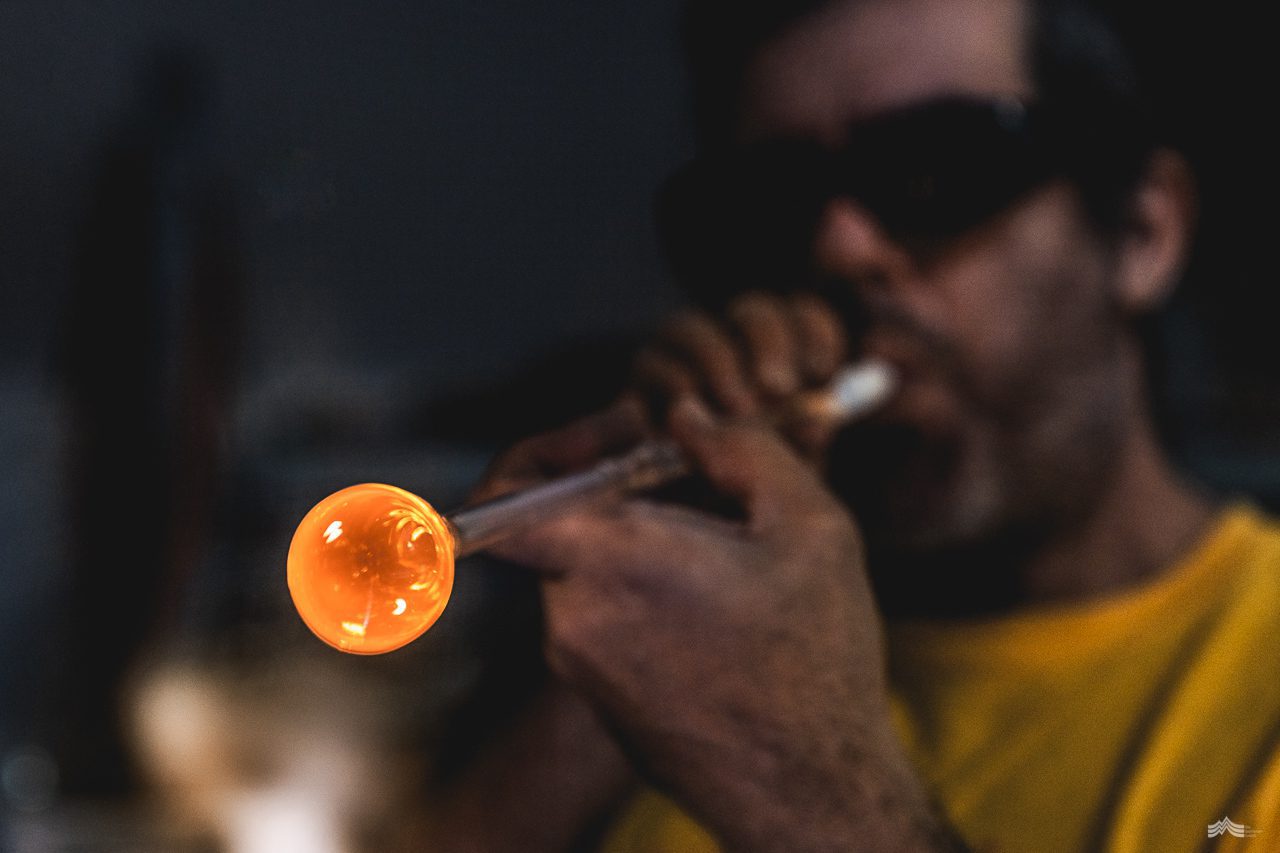
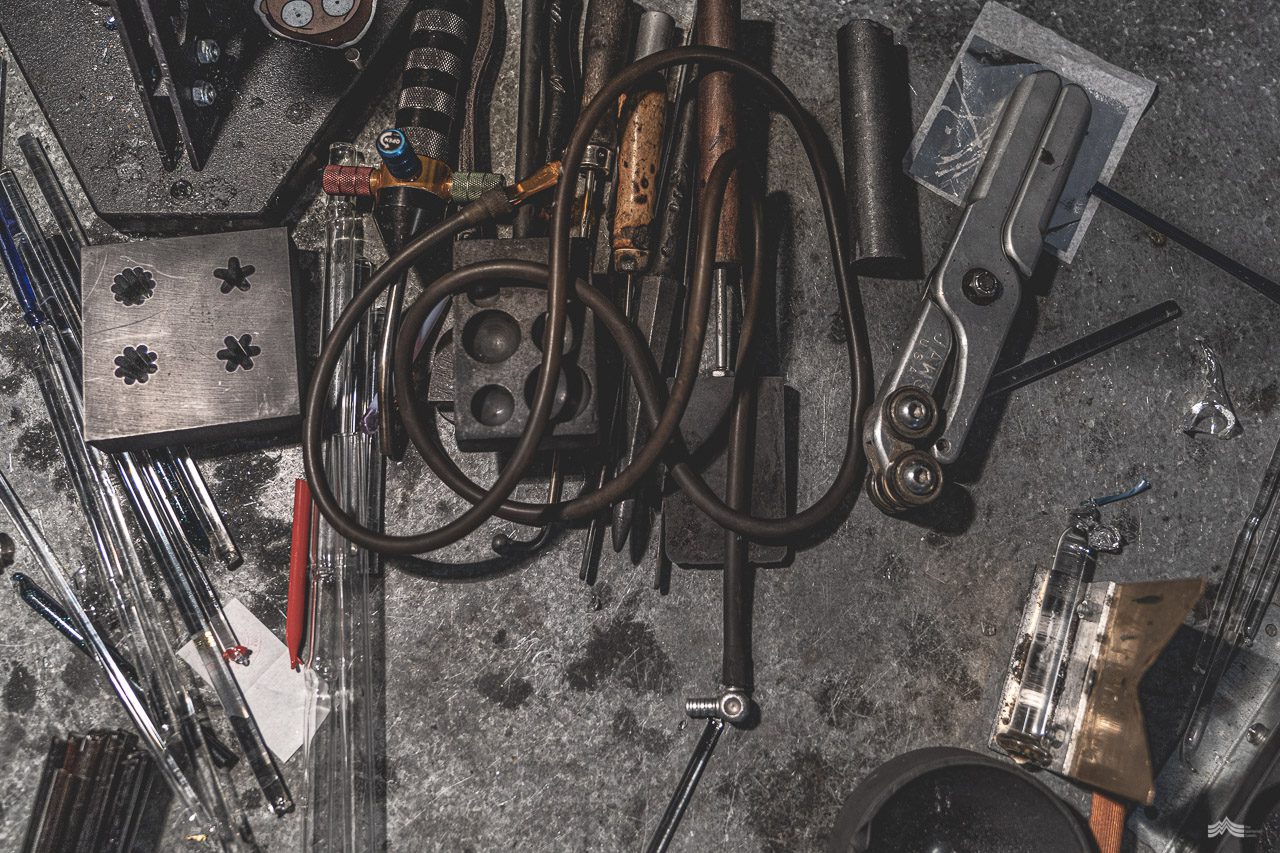
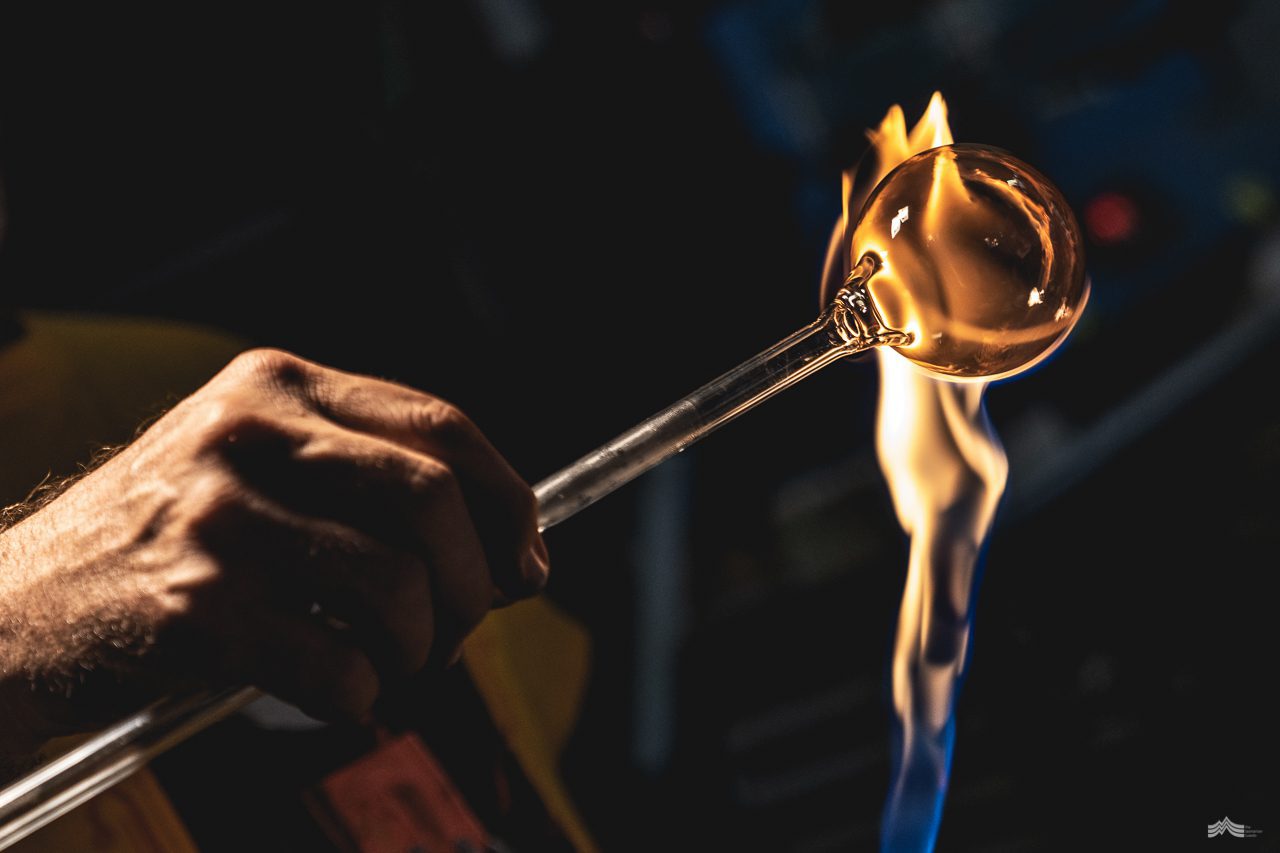
Living in Fitzroy Crossing at the time, Craig found himself bunkered down at an old scrapyard with a tyre fitting bay. “I ended up fitting tyres in between creating a lot of pendants and glass souvenirs for tourists. Believe it or not we had a gallery attached to the tyre place,” he shrugs. “I used to sleep on the gallery floor in my swag – it was easy and it was air conditioned.”
It turns out that fitting tyres in the outback is a pretty lucrative business. “Tyres tend to blow a lot in 40 degree weather, so there are no shortage of customers,” explains Craig. “When the owner wanted to retire I ended up buying the business. Over a coffee and a handshake we agreed that I would pay him off over my first year. That turned into another three years swinging tyres in the heat while running my glass studio on the side. It was a period of time that served its purpose in terms of setting me up, but sitting in the back of my mind was always Tassie.”
“It was a simple longing to do glassblowing in a cool climate. I always knew I’d eventually end up here.”
Speaking of his relocation to Tasmania, Craig is quick to sing the praises of his adopted community. “After getting to Tasmania, one of the Geeveston locals let me work in their shed over summer. There was never a cost, they were just happy to put a roof over my head. That welcome was something I’ll always be grateful for.”
“Around that time this place, an old ice cream factory, popped up for sale,” continues Craig. “It looked like it had potential so I purchased it. After returning to Fitzroy Crossing to work one final season up there, I loaded up a truck and drove everything back down to Tasmania.” It was the fresh start he’d been looking for, with one unexpected twist. “After I bought this place I had to spend a few months cleaning it up…it smelt of putrid ice cream! It was a lot of hard work but it’s now the best creative space I have ever had.”
Watching Craig work with the torch is mesmerising. As he expertly rotates a glass rod over a hot blue flame and applies pressure by blowing into the rod, a gentle bubble begins to form. “It’s a juggling game of heat rising and gravity pulling down, that’s why the glass is always rotated,” he explains, his dexterity making it look effortless. “Transparency definitely adds an extra dimension to glass and I love the scope that that adds…the ability to play with light. The fact that glass acts a lot like water is also what draws me to it.”

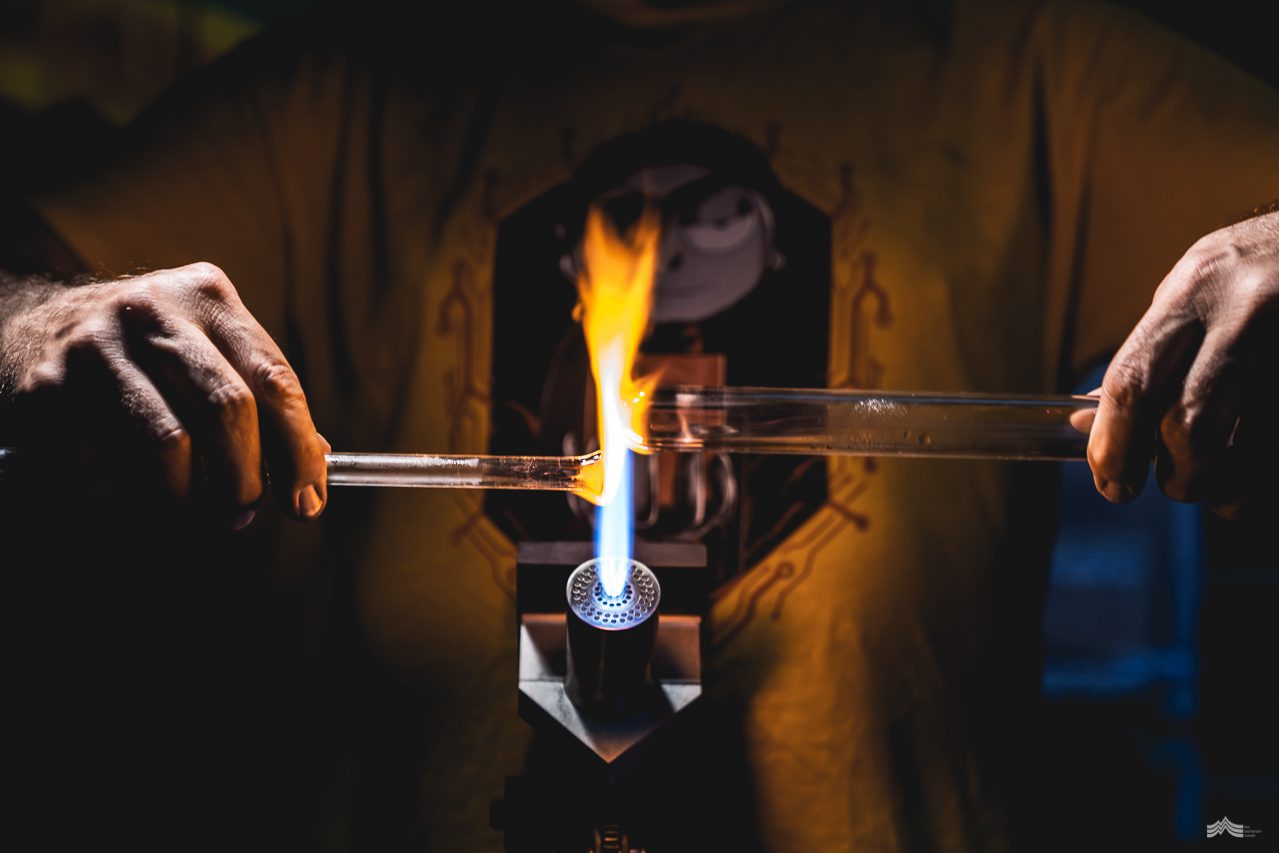
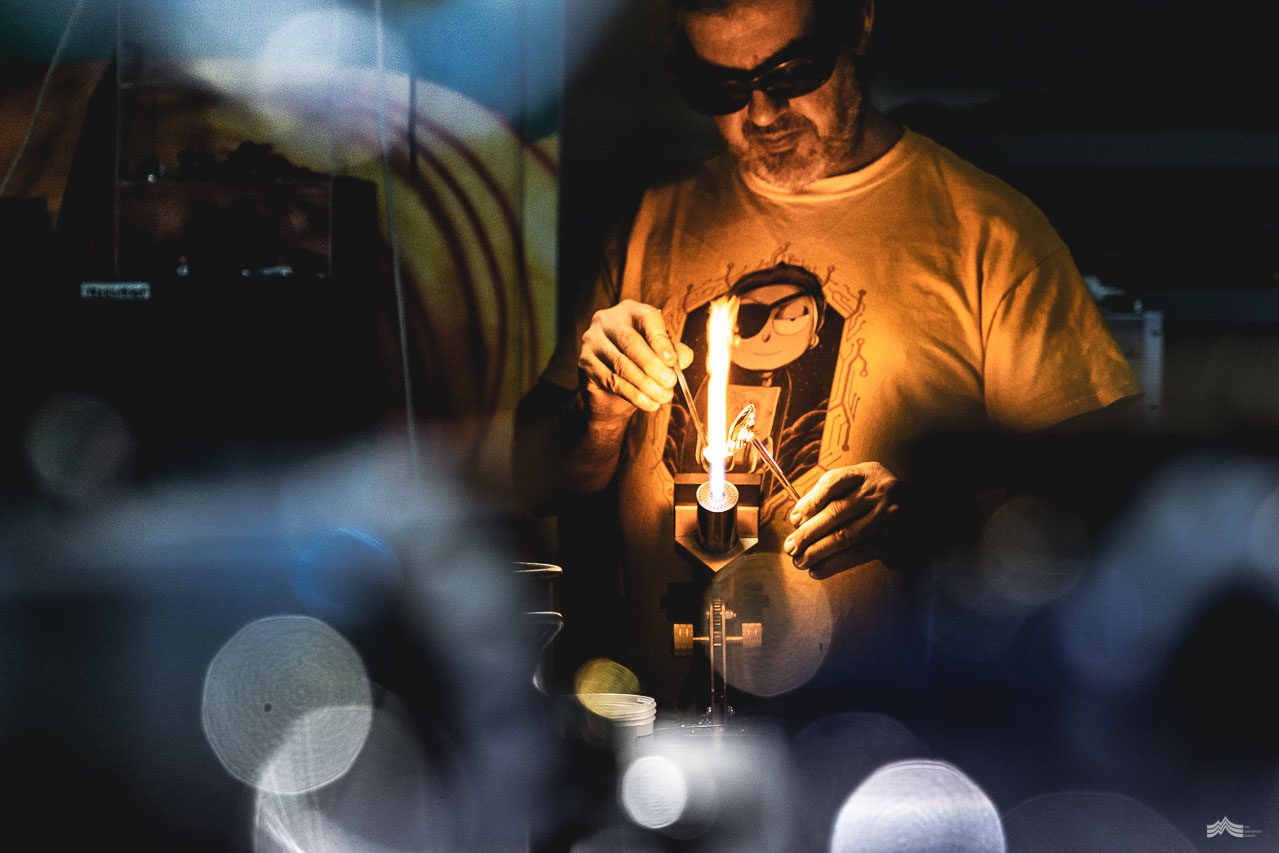
The ancient craft of glassblowing has changed little over the centuries, with the tools of the trade remaining quite similar to their historic counterparts. “Whilst today we can control the temperatures a lot more readily, the basic principles obviously remain the same,” says Craig. “After working the glass it will be placed into the kiln. This allows it to cool under controlled conditions, bringing the various thicknesses of the glass to the one temperature. It’s a process that relieves the stress that glassblowing can cause, reduces thermal shock, and increases the durability of the end product.”
Craig works with borosilicate glass, or Pyrex. “It’s just the same as what oven doors are made out of,” he explains. “It’s as tough as guts and very heat resistant. It’s also the clearest type of glass to work with.” The wide selection of rich colours make it attractive too. Show Craig a new shade and you’ll witness a whole new level of enthusiasm. “I just got a new purple tone in and just can’t wait to use it. I haven’t decided what to make yet.”
A self-taught master, Craig is passionate about achieving technical intricacies that continue to challenge glass blowers across the globe. “Trust me…a whole lot of stuff’s gone in the bin along the way…it’s trial and error. I try something, see how it works out, and then just keep building on that if it’s going in the right direction.”
“I’ve also invented a lot of new tools along the way too,” continues Craig. “A good example is one I use a lot to shape the gills in my mushrooms. It’s simple, effective and I’ve never seen anything that produces a result this good. I’m often asked about how I do it, and always happy to share.”
“These days I don’t mind if I’m copied – it pushes me to take things another step further.”
Beads, marbles, jewellery, vessels and dishes might be the standard fare of a glassblower – and certainly pieces mastered by Craig – but this workshop is defined by quirk. Kooky one off pieces are a Dr Sawfish special. Think tobacco pipes shaped like sharks, fried eggs perched on benchtops, glow in the dark panda bears, and crazy Halloween pumpkins bearing teeth. Expect the unexpected. In Craig’s own words, “If I was smart, I’d probably just make the same thing over and over, but it’s not about that for me.”
“There’s a lot of crazy shit in here, as I just make to satisfy my own taste now. And that’s pretty weird! There’s a lot of freedom in creating for yourself and not catering to an audience.”
The volume of work adorning the workshop is testament to Craig’s commitment to exploring his own boundaries. “I know I can work things out in the end, so I’ll just plod along perfecting a technique until I nail it. I’m always asking myself what I can add next, or try next, to improve a design,” he explains. “I can spend hours in here, in fact until very recently I realised that I hadn’t spent a night away from here in two years…I love it…if something’s on my mind, this certainly keeps my thoughts busy.” Indeed, Craig is a technical genius. While his work might not be to everyone’s taste, no one can deny that his skill level is off the charts. One look at those amazingly detailed glass eyes can tell even an amateur that.
A personal favourite is a mighty red hermit crab. “It’s very challenging to create a piece such as this that is totally hollow,” Craig explains. “I’m really pleased with how he turned out, there are a lot of facets to him. I’ll be very interested to see where he ends up.”
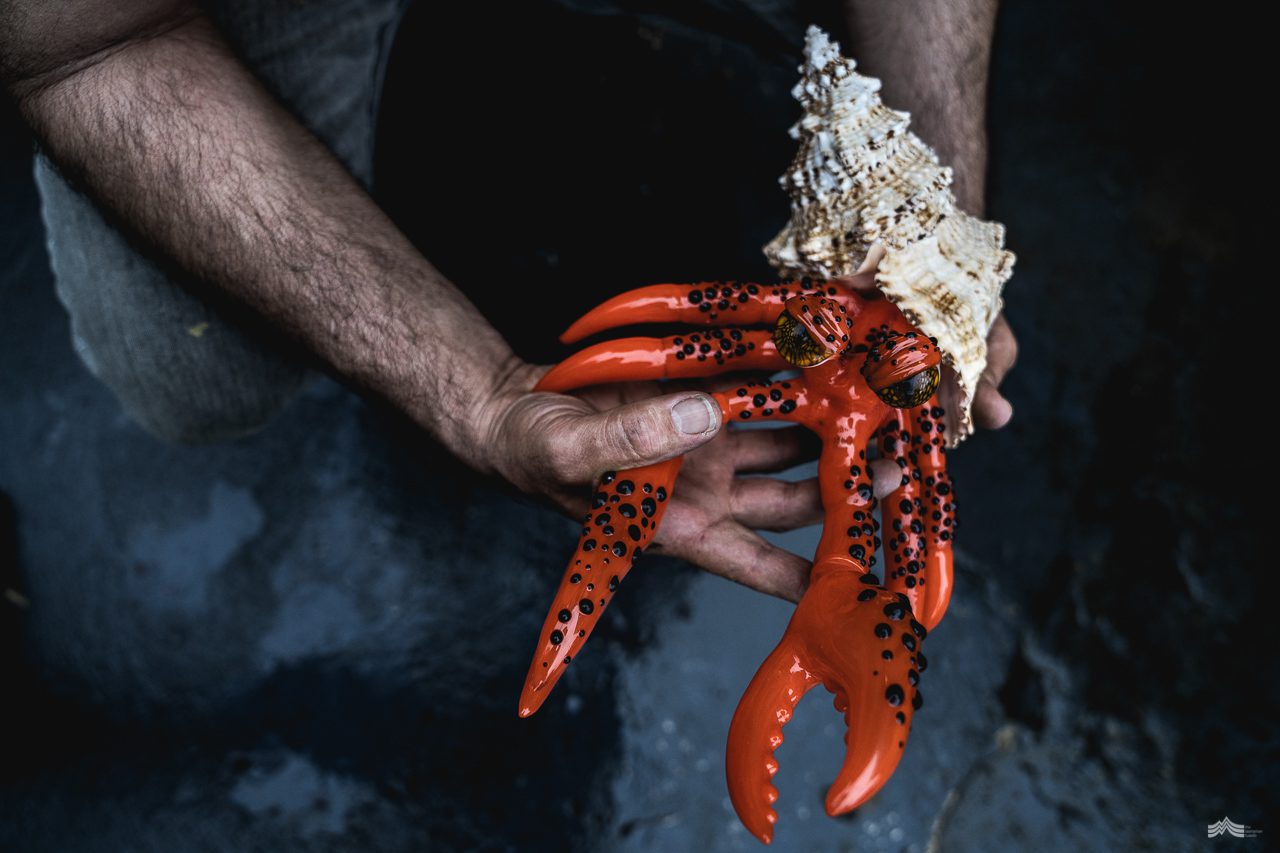
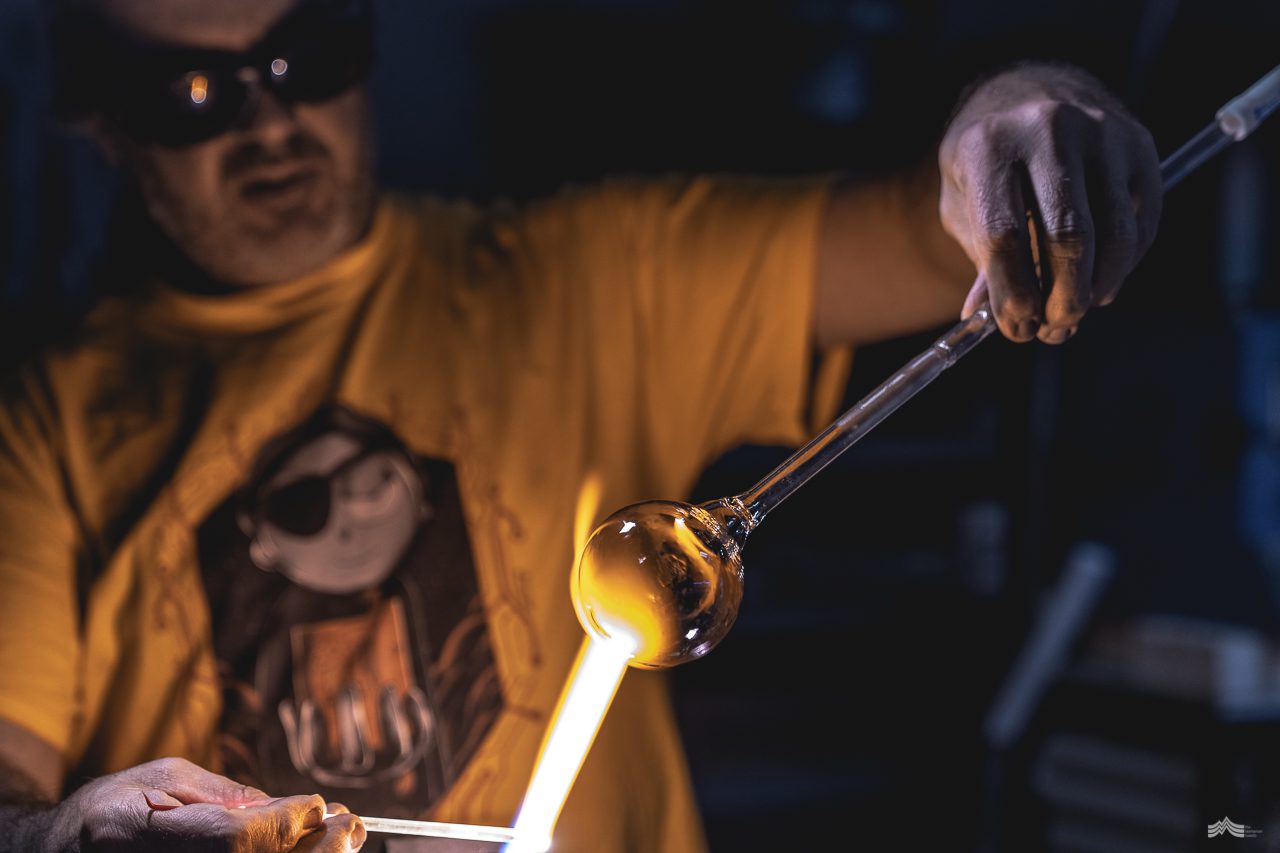
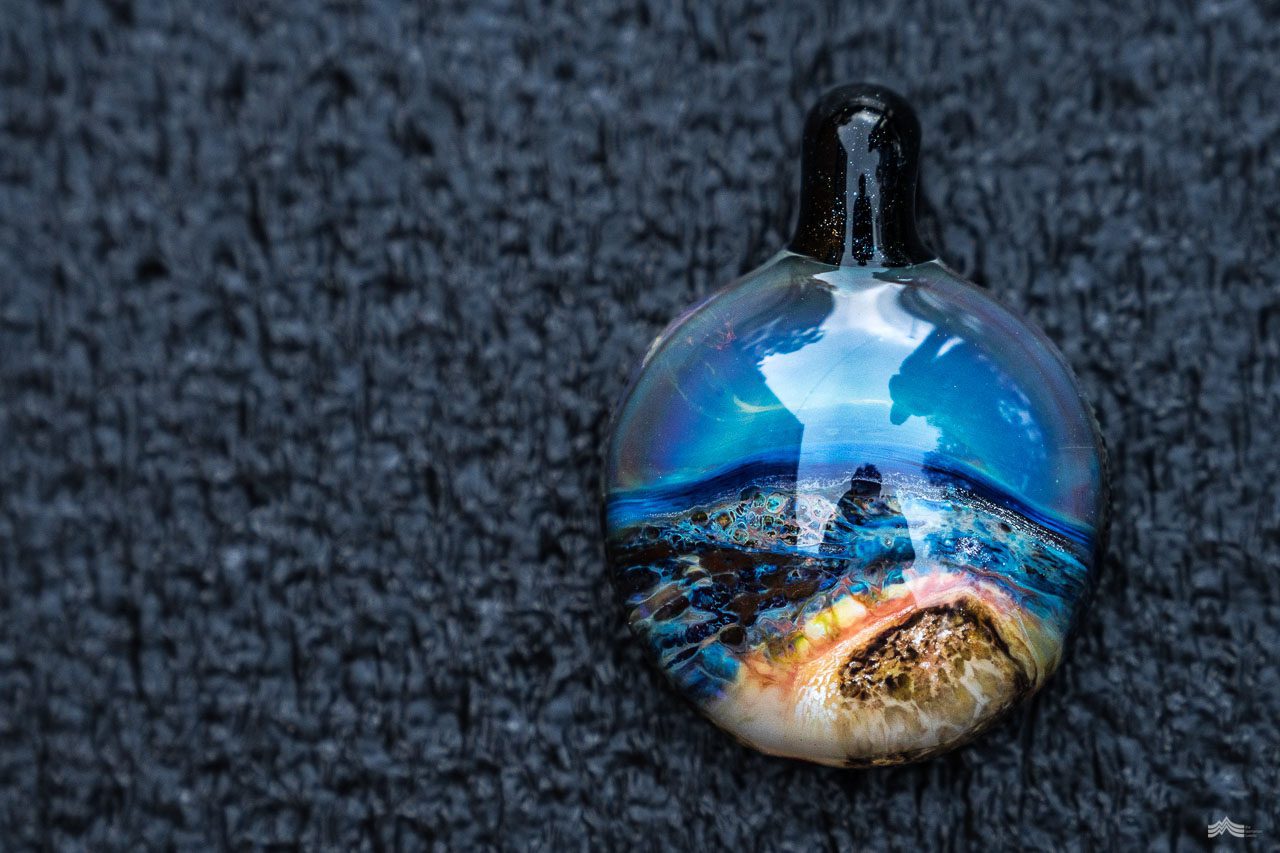
The colours of the Kimberley are evident in many of Craig’s pieces. Rich ochre hues of reds and yellows are prominent. These miniature landscapes are created from the careful swirling and morphing of colours that softly curve together to give the illusion of a globe. Rich corals that inhabit the underwater realm off the coast of Broome seemingly wash against the shore. These striking pendants of dichroic glass sparkle gently in the light and continue to attract the attention of endless buyers online. “Most of my work now is sold online via Etsy,” Craig confirms. “Americans and Europeans mainly.”
Sea creatures are a common theme in Craig’s work. “In fact, they’re also how I ended up with the Dr Sawfish name,” he grins. “Back in Fitzroy Crossing I spent quite a bit of time exploring the river with mates. On one particular trip we were out in kayaks for about five days. There’s a population of freshwater sawfish in that river and I wanted something that was rare and unusual. It seemed a good fit, so hence the name sawfish. The ‘Dr’ is a reference to Dr Seuss – a favourite from my childhood. Incidentally, I have a researcher mate who studies the sawfish. I call him the ‘real Dr Sawfish’.”
Dr Sawfish has a lot to answer for. Craig’s quirky mudskippers have become legendary – particularly the turbo charged ones. “They might feature in a book one day too,” he reveals. “I’m working on a concept to bring some pretty weird mudskipper adventures to life and showcase the amazing variety of landscapes that we have across this country. It might not sell, but it’s going to be a whole lot of fun!”
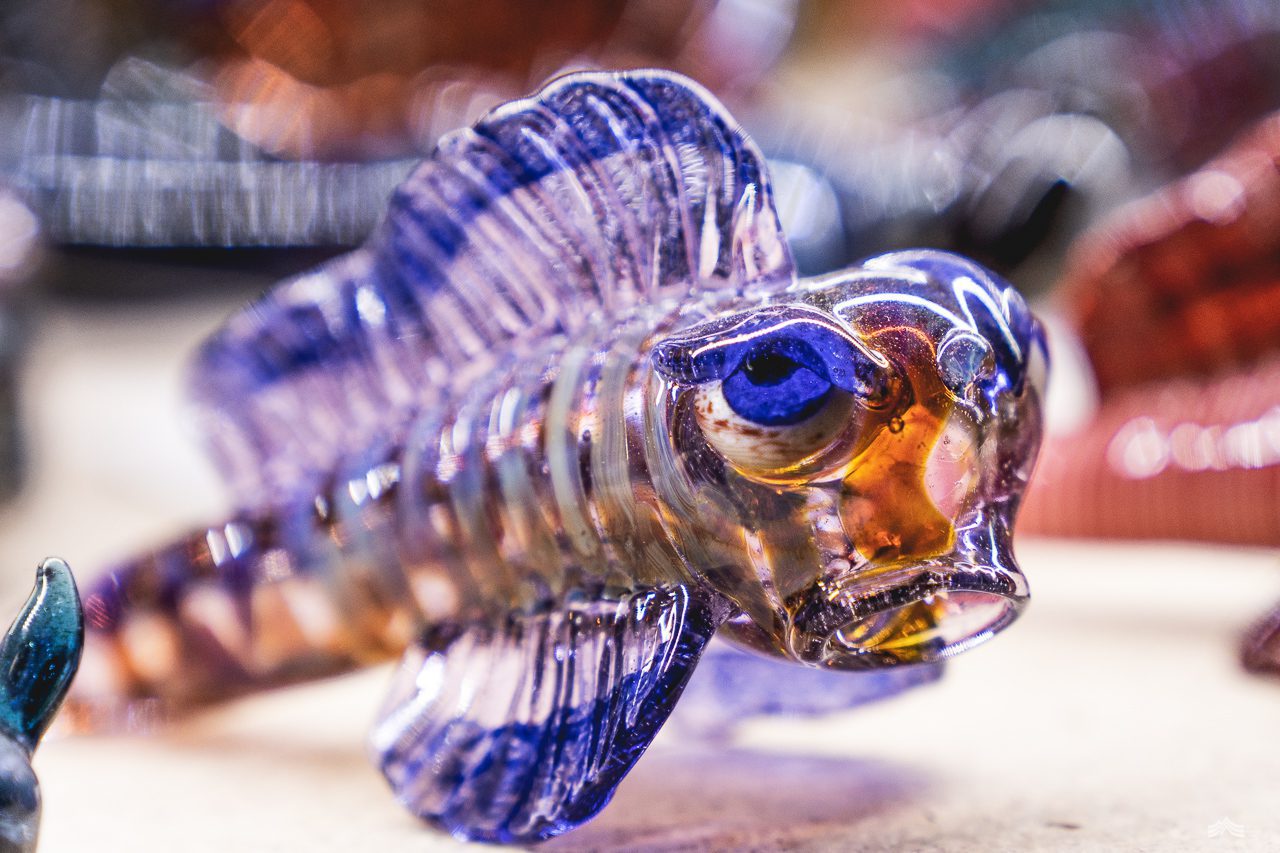
While fiercely independent, Craig is a natural teacher who continues to lend his experience to those wishing to delve into this intriguing artform. “I’ve had a couple of young adults in here lately who were keen to learn. It was fun to have that injection of energy in the studio, especially since I’ve been used to working alone lately. I found it quite infectious.”
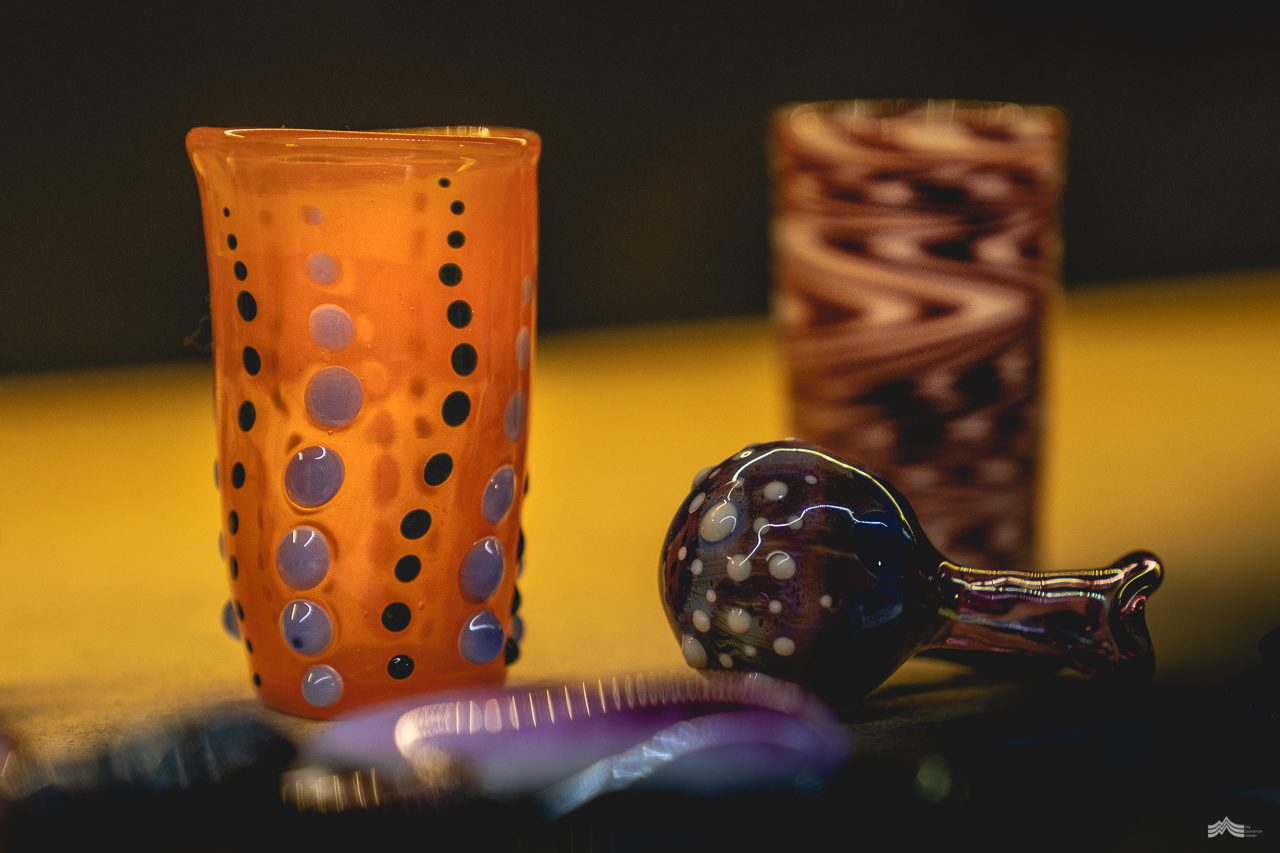
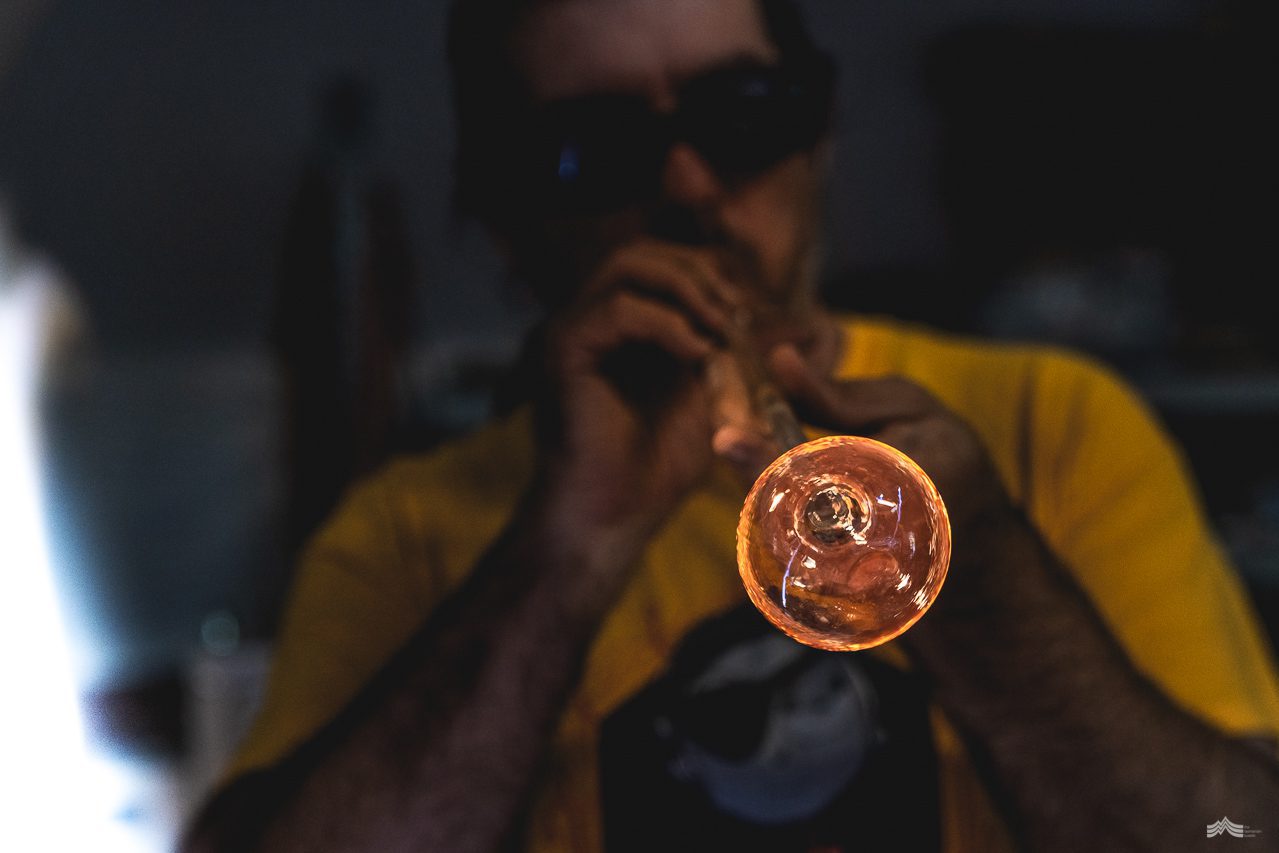
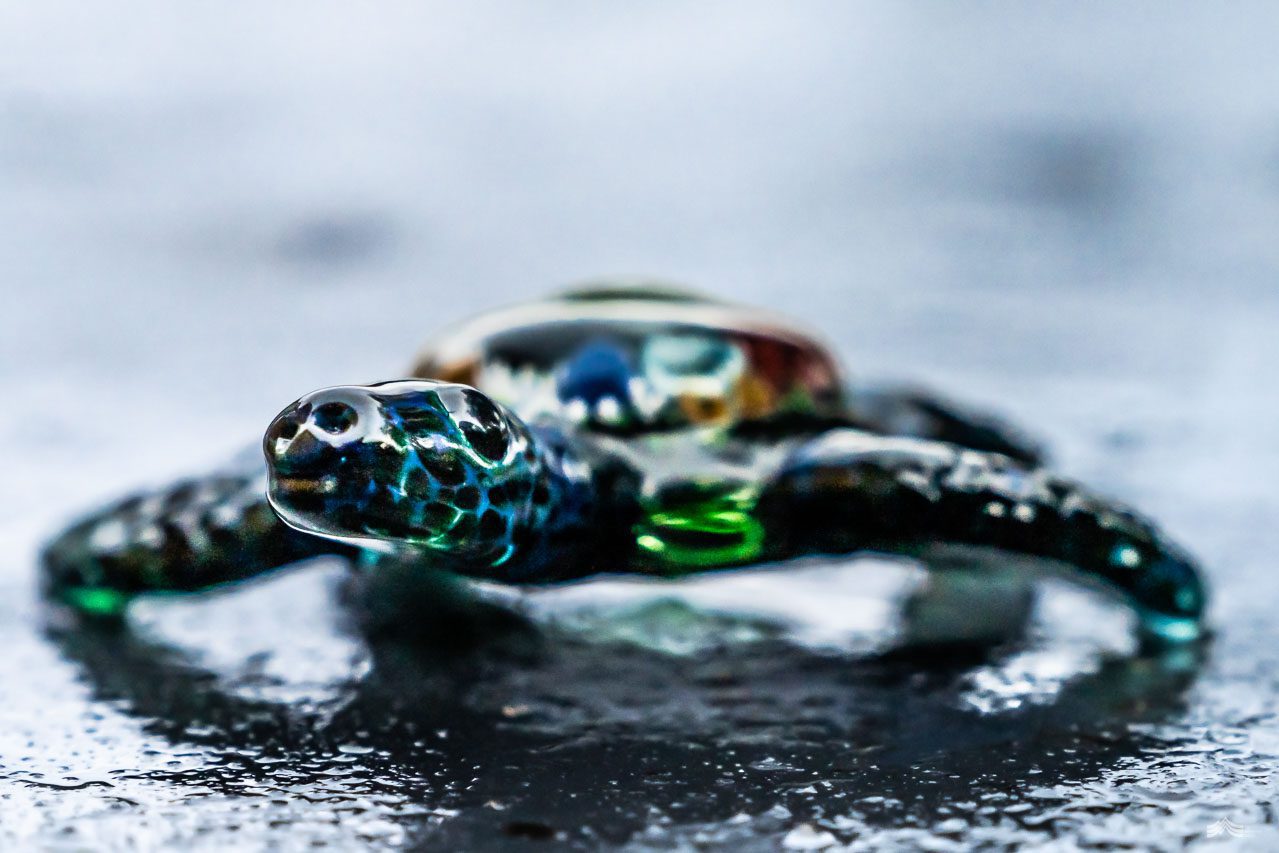
“There’s still such a long way for me to go with my art,” Craig muses. “There are always new things to learn, and I often see something that someone else made and like to see if I can do it better. It’s a bit of a personal challenge really. I’m now at the stage where if I want to make something I know I have the skills to nut it out. It’s just a matter of perseverance until I crack it. Always bettering yourself is where it’s at for me.”
“Life here is dam hard to beat,” nods Craig, motioning to the track that meanders alongside his property. “I’m an early riser and usually start the day at first light with a wander down to the river. There’s nothing quite like splashing ice cold water on your face to wake you up.” Nodding in the direction of his furry companion, he finishes, “Sandy will have a paddle and often we just sit for a while and watch the platypus before we chill out in the workshop for the rest of the day. We both think it’s utopia.”
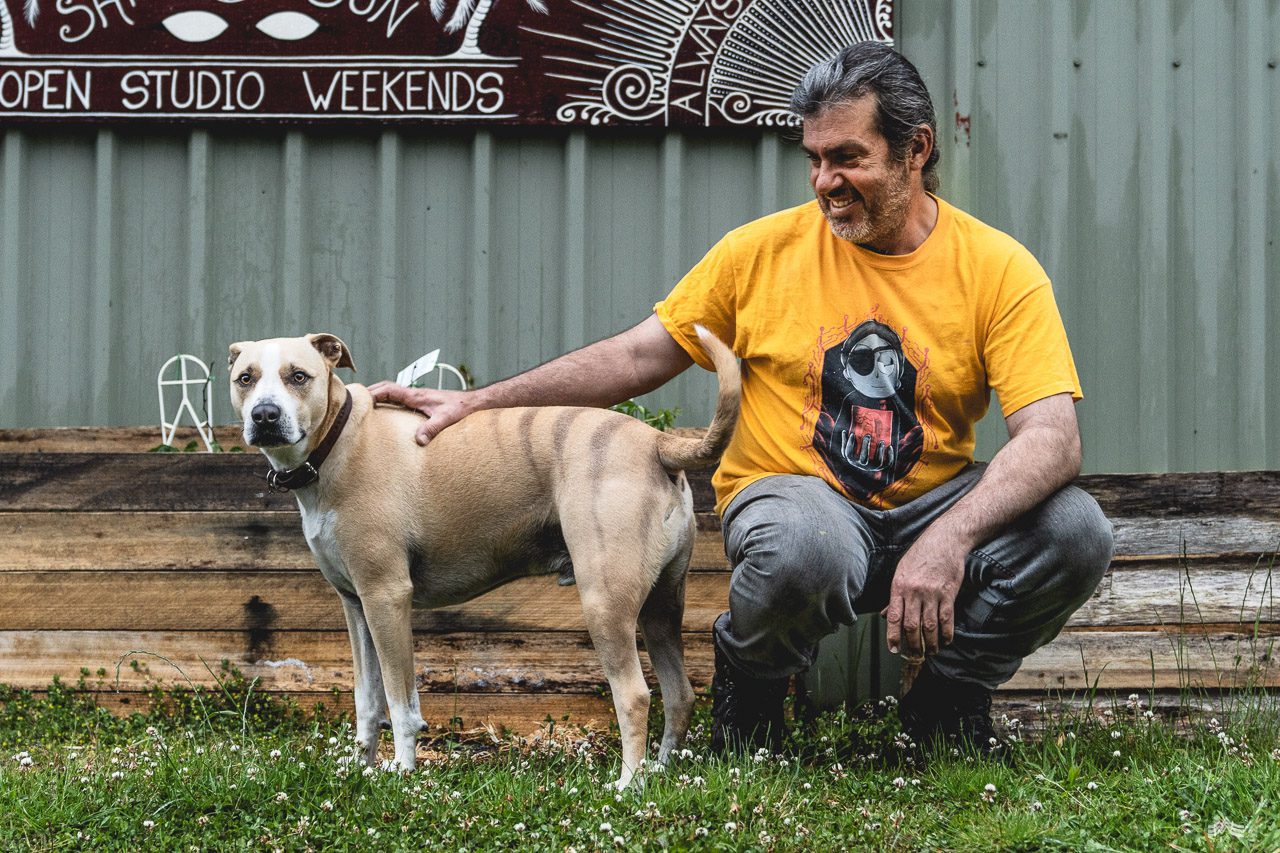
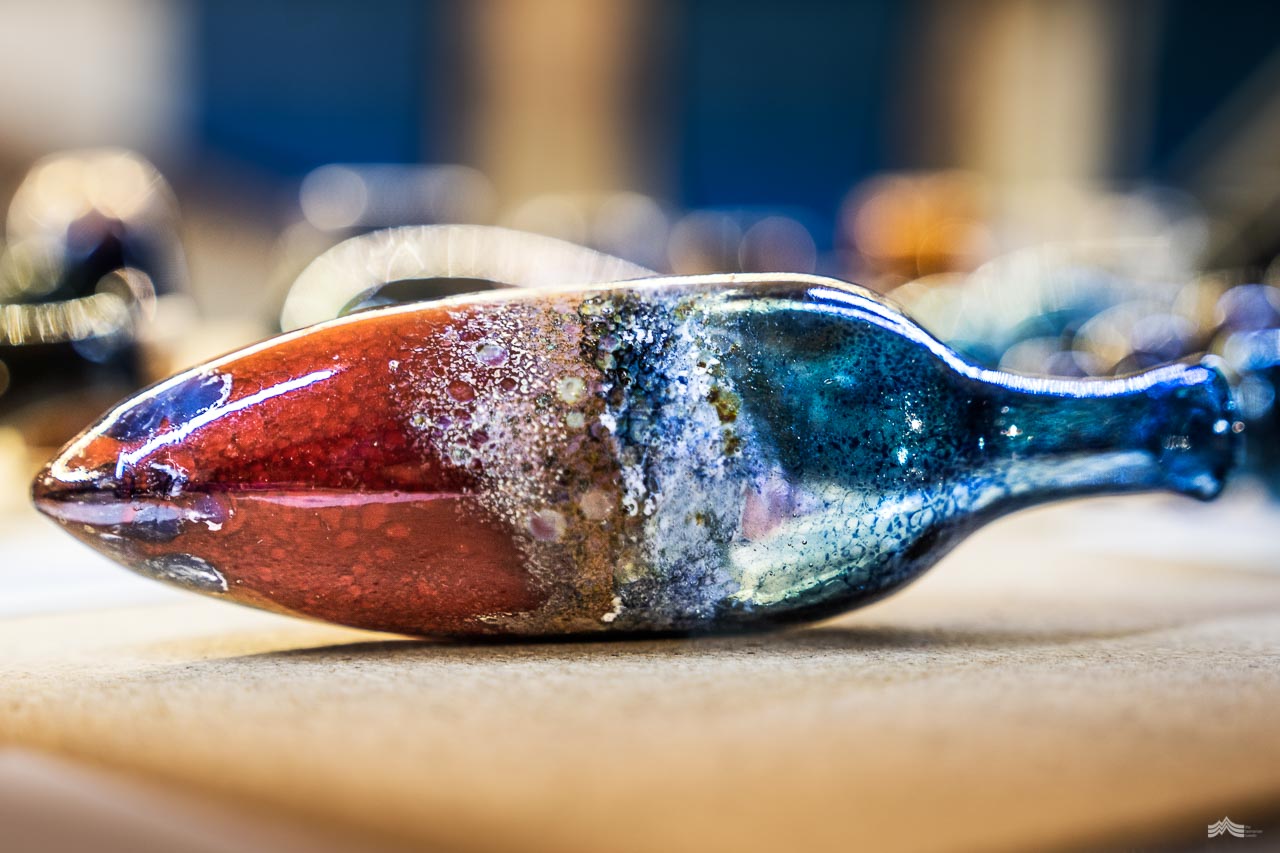
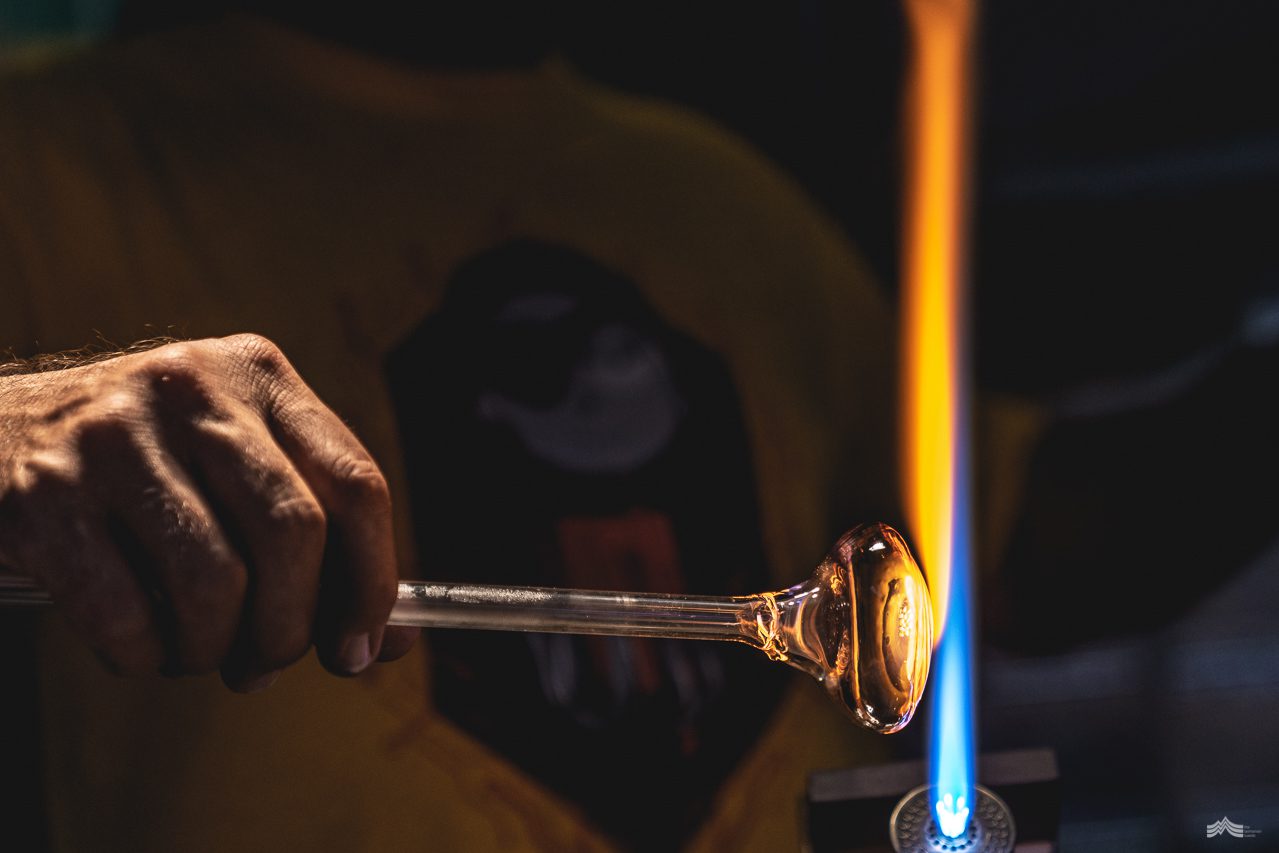
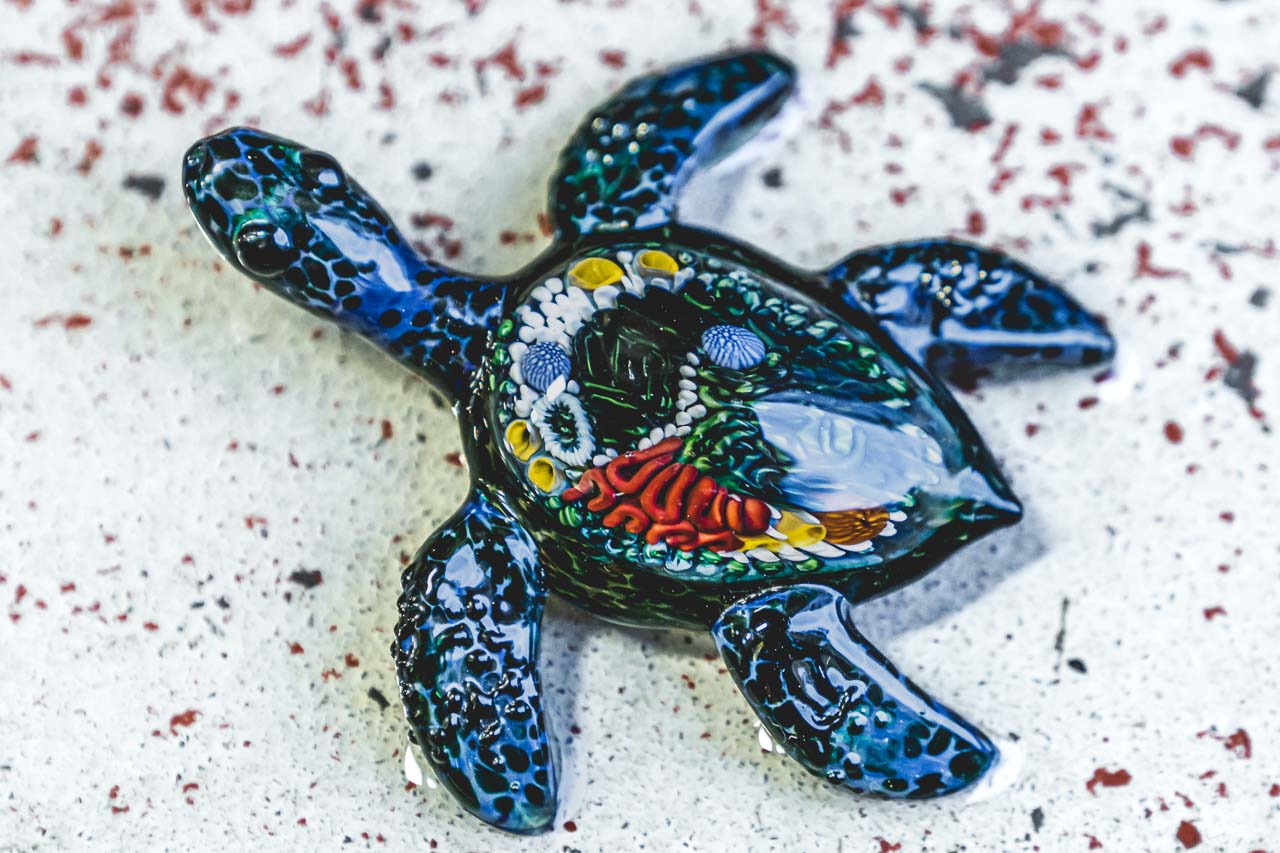
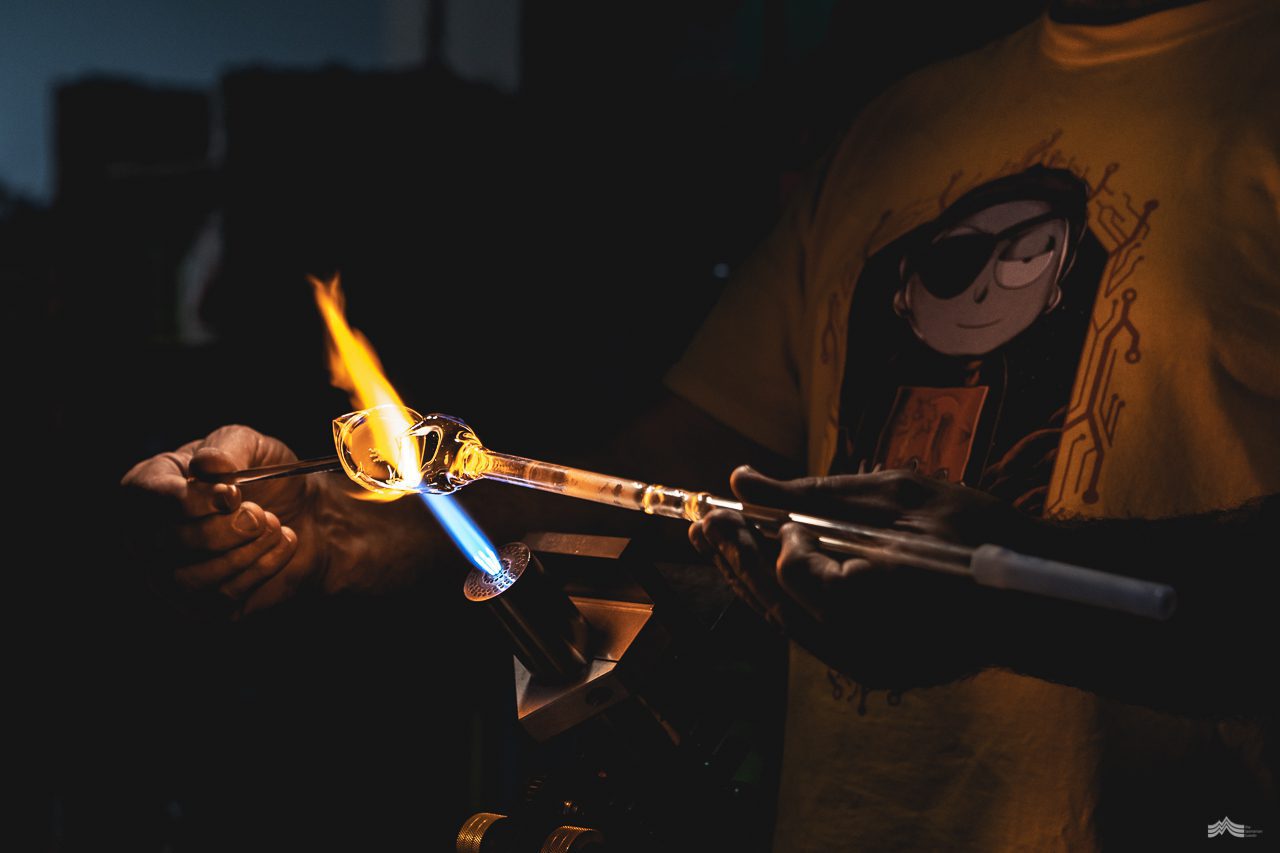
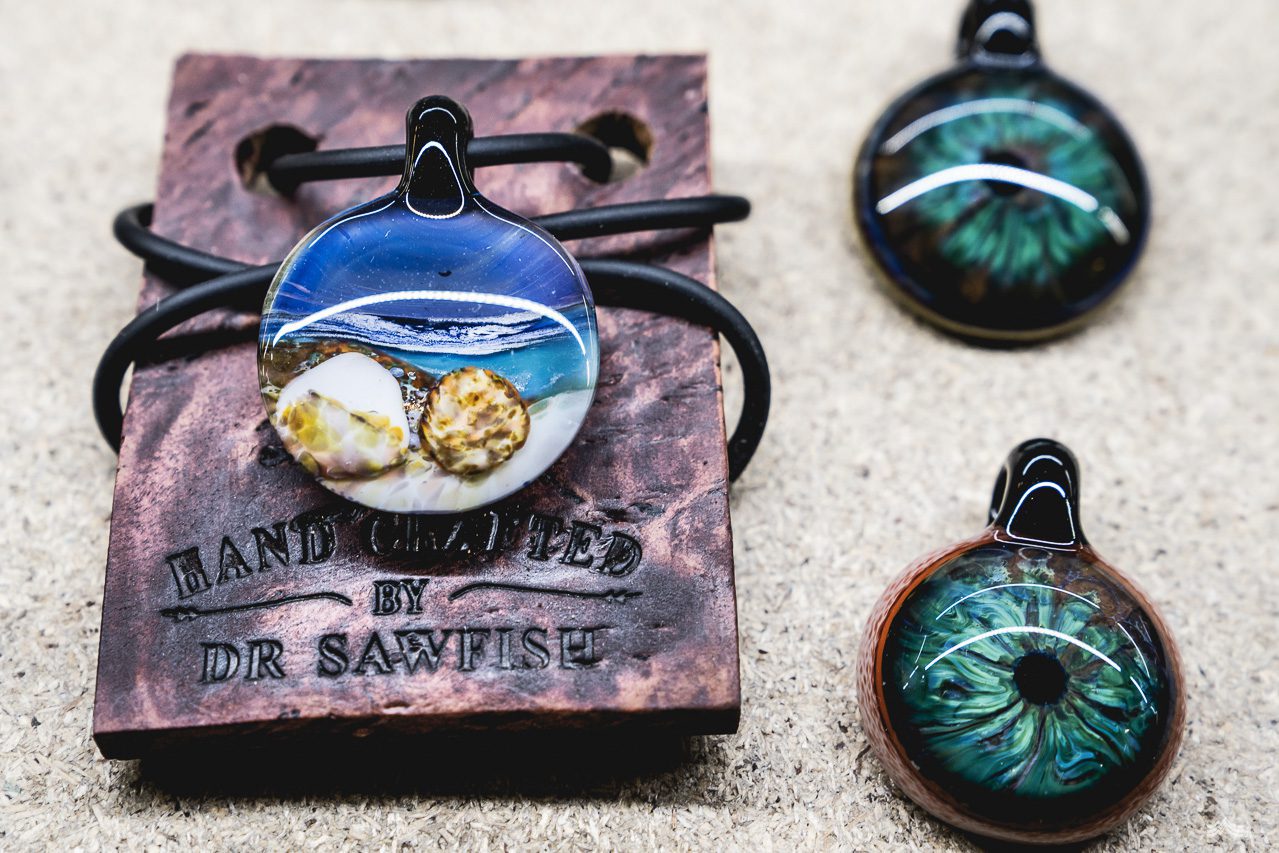
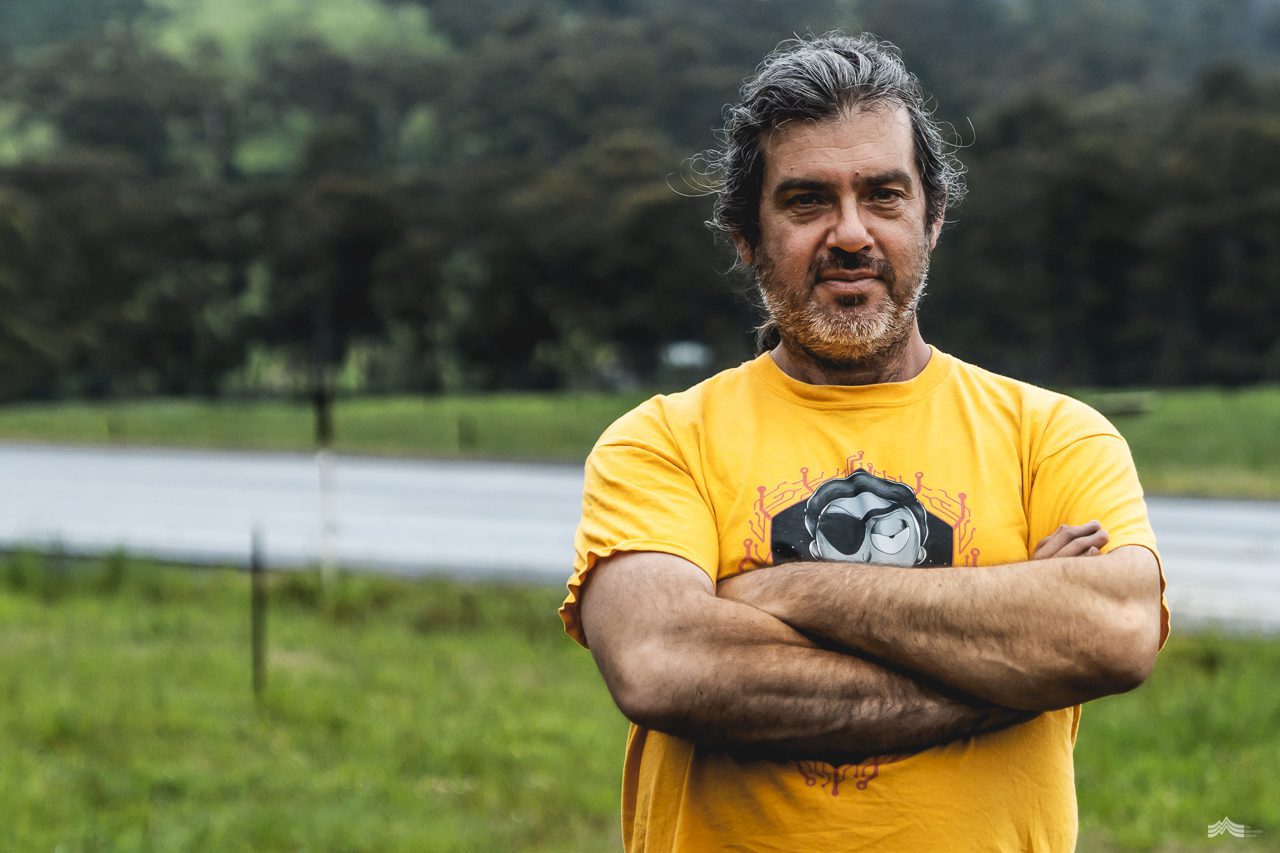
Follow Dr Sawfish’s creative journey on Facebook and Instagram.
Fancy an acquisition? Shop online via Etsy.
This article was a joint collaboration with the Huon Valley Council.
